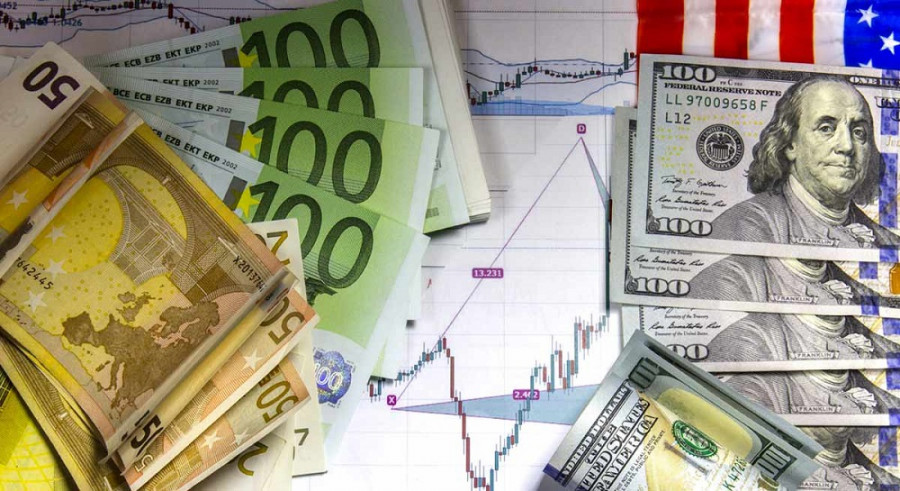The EUR/USD pair is stuck within the 100-point price range, the limits of which are conditionally marked at 1.0570-1.0670. The bears can not get a foothold in the area of the 5th figure, while the bulls can not climb above the 1.0700 target. The limits correspond to the bottom line of the Kumo cloud on the daily chart and the middle line of the Bollinger Bands on the same chart. On the one hand, the pair shows increased volatility, moving within the 100-point range. On the other hand, traders can not decide on a direction: the downtrend has evidently stopped, however, it is too early to speak about the revival of the upward movement.
European inflation and Lagarde
Thursday's reports did not support the euro, though they were in favor of the single currency. The euro area annual inflation in February fell below expectations, instead of falling to the forecasted decline to 8.2%, it came out at 8.5%. This situation was mainly due to the rise in food, tobacco and alcohol prices, which increased by 15%. Take note that, for the first time in many months, energy prices are no longer the driving force behind the rise in the cost of living in the eurozone.

The core CPI, excluding energy and food prices, showed an uptrend again, rising to 5.6%. This is yet another historical record, i.e., the highest value of the indicator in the entire history of observations (since 1997). The result was higher than most experts had expected: analysts polled by Reuters had expected the index to remain at its January level, i.e., 5.3%.
Such figures should have supported the euro, but in fact the pair dropped by almost 100 pips, again falling in the area of the 5th figure. European Central Bank President Christine Lagarde put a stop to the uptrend, as she said that although inflation rose "slightly" in February, it will fall "much more" in March due to the underlying effect of a comparison with last year's high energy prices. At the same time, she assured markets that the central bank would raise rates by 50 points at the March meeting. And the further pace of monetary tightening will depend on incoming data. Also, Lagarde didn't answer the question about the size of the final rate, citing the uncertainty of the situation.
In other words, Lagarde didn't toughen her rhetoric in response to the February CPI report. Moreover, she suggested that March figures would reflect a "more significant" slowdown in inflation. Such comments put pressure on the euro, afterwards the pair lost ground.
The euro lost, but the dollar did not win
Although the euro weakened, the EUR/USD bears did not benefit from the situation either. The greenback did not receive any support from the US Bureau of Labor Statistics report, according to which unit labor costs in the nonfarm business sector increased 3.2% in the fourth quarter of 2022. The result was much higher than market expectations of 1.6% and triggered growth of treasury yields.
The increased risk appetite in the markets prevented the dollar bulls from showing their character. Strong Chinese data (PMIs for manufacturing and non-manufacturing, business activity index in the services sector by Markit) contributed to strengthening of risk sentiment. In addition, the dollar was under pressure after the Atlanta Federal Reserve head Rafael Bostic made unexpectedly soft remarks. He said he was in favor of a 25 basis points rate hike at the next meeting (he was against the implementation of the 50 bps hike that the market began discussing after the latest inflation report). At the same time, Bostic noted that the U.S. central bank may suspend the current tightening cycle "by mid to late summer".
Several U.S. macro data out this week also contributed to the fundamental picture. For instance, the ISM PMI manufacturing index was in a recession zone (it only rose to 47.7 while the growth forecast was 48.5). Consumer confidence was also in the red zone, coming in at 102.9 (a downtrend registered for the second straight month). The Fed-Richmond Manufacturing Index also disappointed, falling to -16 points.
All these factors put pressure on the greenback, preventing the bears from consolidating within the 5th figure.
Conclusions
Both bulls and bears can not leave the 1.0570-1.0670 range, within which the price has been fluctuating for the third straight day. Considering the contradictory fundamental background, it would be better to take a wait-and-see stance: the downtrend has stalled, but the price has not increased, which indicates that it is still stuck in a sideways loop. I expected the current trading week to probably end within the aforementioned price range - there are no arguments in favor of an upward or downward breakout.
The material has been provided by InstaForex Company - www.instaforex.comfrom Forex analysis review https://ift.tt/xocmDy9
via IFTTT
